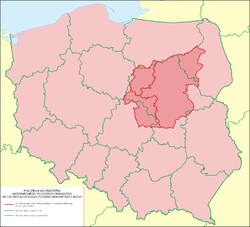
Back مازوفي Arabic Mazoviya Azerbaijani Мазовія Byelorussian Мазовія BE-X-OLD Мазовия Bulgarian Masòvia Catalan Mazovsko Czech Masovien Danish Masowien German Mazowska DSB
Mazovia
Mazowsze | |
|---|---|
| |
 Three historical Mazovian voivodeships in comparison with contemporary Polish voivodeships | |
| Country | |
| Time zone | UTC+1 (CET) |
| • Summer (DST) | UTC+2 (CEST) |
| Primary airports | Warsaw Chopin Airport Warsaw Modlin Airport |
| Highways | |
Mazovia or Masovia (Polish: Mazowsze [maˈzɔfʂɛ] ) is a historical region in mid-north-eastern Poland. It spans the North European Plain, roughly between Łódź and Białystok, with Warsaw being the unofficial capital and largest city. Throughout the centuries, Mazovia developed a separate sub-culture featuring diverse folk songs, architecture, dress and traditions different from those of other Poles.
Historical Mazovia existed from the Middle Ages until the partitions of Poland and consisted of three voivodeships with the capitals in Warsaw, Płock and Rawa. The main city of the region was Płock,[1] which was even capital of Poland from 1079 to 1138; however, in Early Modern Times Płock lost its importance to Warsaw, which became the capital of Poland. From 1138, Mazovia was governed by a separate branch of the Piast dynasty[citation needed] and when the last ruler of the independent Duchy of Mazovia died, it was fully incorporated to the Polish Crown in 1526. During the Polish–Lithuanian Commonwealth over 20% of Mazovian population was categorized as petty nobility. Between 1816 and 1844, the Mazovian Governorate was established, which encompassed the south of the region along with Łęczyca Land and south-eastern Kuyavia. The former inhabitants of Mazovia are the Masurians, who since the Late Middle Ages settled in neighboring southern Prussia, a region later called Masuria, where they converted to Protestantism in the Reformation era, thus leaving Catholicism, to which their relatives from Mazovia still adhered.
The borders of contemporary Mazovian Voivodeship (province), which was created in 1999, do not exactly reflect the original size of Mazovia, as they do not include the historically Mazovian cities of Łomża and Łowicz, but include the historically Lesser Polish cities of Radom and Siedlce.
- ^ Mazowsze: Obraz Etnograficzny, Volume 1, by Wojciech Gerson and Oskar Kolberg, BiblioBazaar, 2009 – 372 pages






